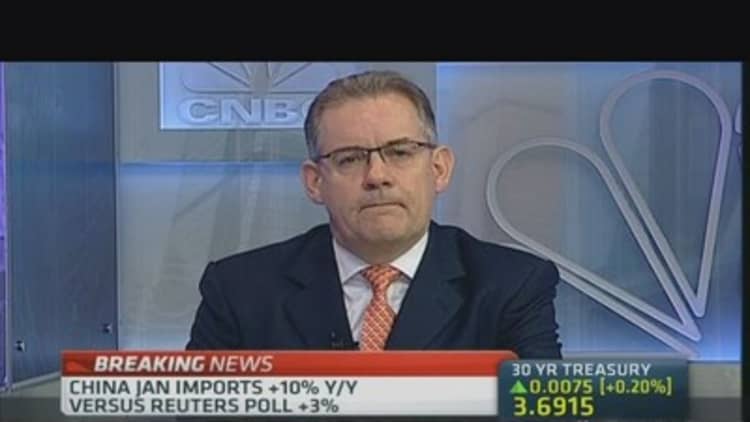
China released a batch of blowout trade numbers on Wednesday, which many analysts attribute to distortions created by the Lunar New Year holidays.
The country's exports jumped 10.6 percent in January from the year-ago period, compared to a Reuters forecast for a 2 percent rise and higher than the 4.3 percent rise recorded in December.
Imports, meanwhile, rose an annual 10 percent in the month, versus expectations for a 3 percent rise and compared to the 8.3 percent gain in the month before.
(Read more: China is now cheaper than Turkey)
This leaves the country with a trade surplus of $31.9 billion for the month, the Customs Administration said, compared to the $23.7 billion forecast by Reuters.
"As there is the New Year distortion, it's always very hard to read the first three months of China's trade," said Bert Hofman, chief economist of East Asia and Pacific at the World Bank.
China's economic data tend to be skewed during this week-long holiday, which began at the end of January this year, with many businesses winding down operations.
(Read more: How big is China's economy, really?)
The overall trade picture however remains encouraging, Hofman added, referring to the 26 percent annualized growth in exports recorded in the final quarter of 2013.
"26 percent growth is very high so that's not a number we are going to expect – it might taper a little bit – but we do see continued positive export growth throughout the year, not just for China but over the world," he told CNBC.
According to Andrew Sullivan, director of Asian sales trading at Kim Eng Securities, the figures, if a bit skewed, show that China is able to maintain its growth momentum despite policymakers' push to rebalance the economy.
"Overall, it is quite encouraging. I mean on the basis that China is still moving itself from being export-driven to looking at boosting growth in its domestic market. It's still managing to maintain its source of income to be able to achieve that," Sullivan said.
(Read more: Is copper's swoon a bad omen for China?)
The data fly in the face of other recent indicators pointing to a weaker start for 2014 for the world's second biggest economy.

The HSBC's final Purchasing Managers' Index (PMI), for example, fell to 49.5 in January from 50.5 in December, its lowest level in six months.
Michael Every, head of financial markets research for Asia-Pacific at Rabobank, said it is impossible to derive any indication of China's economic health from the trade numbers, describing them as "suspicious."
"If you think about it, China's reporting trade up 10 percent year on year in exports, who is it exporting to?" he told CNBC.
"If you look at the 12-month moving average, back in December, Hong Kong was accounting around half of the growth in exports. That's one little tiny city next to the huge mainland economy. So I do think there's strong possibility some of that is reflecting cross-border trade which is artificially distorting these numbers," Every said.
(Read more: Friend or foe: How does the US view China?)
Authentic or not, markets seem to be taking the news favorably.
The Australian dollar gained more than a third of a U.S. cent on the data, rising to $0.9060, pulling closer to this year's peak of $0.9087. China is Australia's top export market and the currency is typically sensitive to Chinese data.
Asian equities were mostly higher, with Japan's Nikkei leading the rise with a 1 percent gain.
— By CNBC's Li Anne Wong. Follow her on Twitter: @LiAnneCNBC

